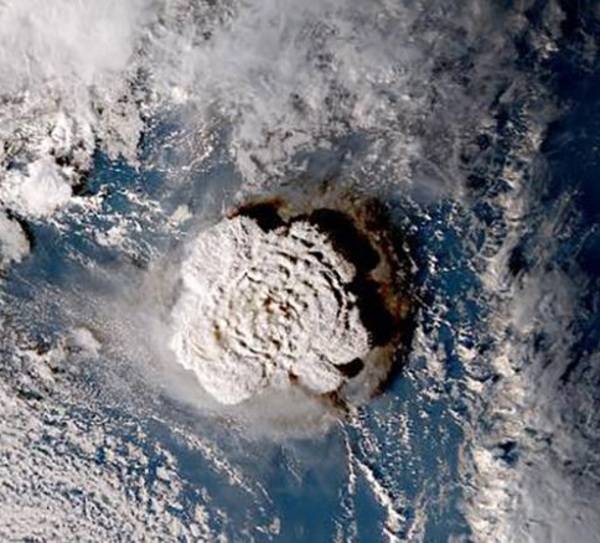Tonga volcanicexplosion
A Current Crisis

Satellite Image Sourced From The World Factbook on CIA.gov
May 2, 2023
This undersea volcano erupted on January 15, 2022, and was “larger than any natural explosion in the past century” (Patel). Scientists studied the blasts and their effects, and claimed it to be “around 1,000 times more powerful than the bomb that was dropped on Hiroshima” (Davis). A NASA satellite even captured footage of the explosion. The video includes water vapor that was released into the atmosphere, which could impact global warming. The amount of water vapor was compared to “58,000 olympic-size swimming pools” (“Tonga”). The explosion also triggered Tsunami waves (Conroy). Scientists claim that this incident was so impactful because of their lacking prediction systems that did not warn the right people in time. This was an unexpected and unprecedented event that has shocked scientists around the world.
While this did occur last year, scientists just released their study on April 14, 2023. A major aspect of their study was a simulation of the disaster that they developed “using satellite data, field observations and drone mapping” (Patel). You can watch a simulation on the National Oceanic and Atmospheric Administration’s website. Their recreation shows the magnitude of this event, the dangers, and the potential damages that could have occurred. The explosion consisted of 5 blasts, each increasing in power as they came, causing it to set records such as most water vapor released into the atmosphere by any volcanic eruption, highest volcano plume at 36 miles high, and “the fastest atmospheric waves ever observed at 720mph” (Patel). The atmospheric waves circled the planet 6 times, becoming a global issue, rather than a regional one. Some of the ground damage on the island, however, consisted of “downed trees and vegetation high along the coast” (Patel). Nearly 500 miles away on the island of Fiji, people reported buildings shaking. The total number of casualties of this event is 6 people, but there could have been more (Davis). The tsunami waves as a result reached up to “85 meters high within one minute of the eruption” (Conroy). Scientists did not expect this disaster, and therefore did not put safety measures in place prior.
The main reason as to why casualties were less than expected is because tourist resorts were closed due to the pandemic (Davis). In light of this incident, scientists have released statements claiming they aim to develop and experiment with new technologies for “early warning systems and community preparedness” (Patel). As students, we can stay updated on natural disasters such as this one to effectively influence the future of science and environmental activism. We can take it upon ourselves to learn about scientific technologies, potential environmental legislation, causes of natural disasters, and solutions for a healthier and safer planet for all.
Works Cited
Conroy, Gemma. “Tonga volcano eruption triggered ‘mega-tsunami’.” nature.com, 14 April 2023, https://www.nature.com/articles/d41586-023-01272-x.
Davis, Nicola. “Tonga volcano explosion equalled most powerful ever US nuclear test.” Theguardian, 14 April 2023, https://www.theguardian.com/world/2023/apr/14/tonga-volcano-explosion-equalled-most-powerful-ever-us-nuclear-test.
Patel, Kasha. “The power of a volcanic eruption: This one was bigger than any U.S. nuclear blast.” Washintonpost.com, 14 April 2023, https://www.washingtonpost.com/climate-environment/2023/04/14/tonga-volcano-explosion-destruction-study/.
“Tonga Eruption Blasted Unprecedented Amount of Water Into Stratosphere.” jpl.nasa.gov, 02 Aug. 2022, https://www.jpl.nasa.gov/news/tonga-eruption-blasted-unprecedented-amount-of-water-into-stratosphere.









































